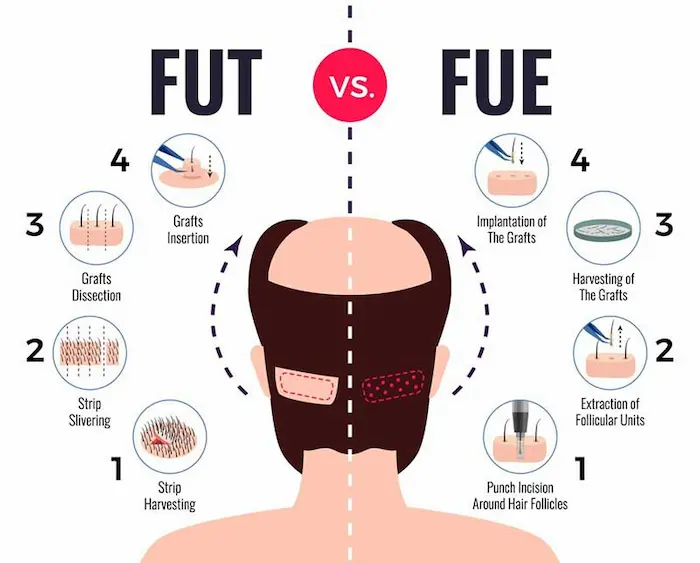
Comparative Analysis of FUE and FUT for Hair Restoration
Hair loss is a common concern for many individuals, and as technology continues to advance, various hair transplantation techniques have emerged as effective solutions.
Hair loss is a common concern for many individuals, and as technology continues to advance, various hair transplantation techniques have emerged as effective solutions. Two prominent methods are Follicular Unit Extraction (FUE) and Follicular Unit Transplantation (FUT). In this comprehensive article, we will delve into the intricacies of these two procedures, exploring their differences, advantages, disadvantages, and factors to consider when choosing between them.
Understanding FUE (Follicular Unit Extraction)
FUE is a minimally invasive hair transplant procedure that involves harvesting individual hair follicles from the donor area, typically the back or sides of the scalp, and transplanting them into the recipient area, where hair loss is evident. This technique gained popularity due to its reduced scarring and faster recovery compared to traditional methods like FUT.
Harvesting Process in FUE
In FUE, the surgeon extracts individual hair follicles using a small, circular punch tool, ranging from 0.8 to 1.0 mm in diameter. This precision allows for the extraction of follicular units without the need for a linear incision, resulting in tiny, round scars that are often barely visible.
Advantages of FUE
Minimal scarring: FUE leaves small, dot-like scars that are less noticeable than the linear scar associated with FUT.
Quick recovery: Patients usually experience a faster recovery time, allowing them to return to their regular activities sooner.
Less discomfort: FUE is generally associated with less post-operative pain and discomfort compared to FUT.
Disadvantages of FUE
Time-consuming: FUE procedures can be time-consuming, as each follicular unit is individually extracted.
Limited graft numbers: The number of grafts that can be harvested in a single session is often lower compared to FUT, which may be a limiting factor for individuals with extensive hair loss.
Understanding FUT (Follicular Unit Transplantation)
FUT, also known as the strip method, involves removing a strip of scalp tissue from the donor area, dissecting it into individual follicular units, and transplanting these units into the recipient area.
Harvesting Process in FUT
In FUT, the surgeon removes a narrow strip of scalp from the donor area, typically from the back of the head. The donor area is then sutured, leaving a linear scar that can be concealed by surrounding hair. The strip is then divided into individual grafts, each containing one or more hair follicles.
Advantages of FUT
Higher graft yield: FUT allows for the extraction of a larger number of grafts in a single session, making it suitable for individuals with extensive hair loss.
Quicker harvesting: FUT is generally quicker than FUE since it involves extracting a strip of tissue rather than individual follicles.
Disadvantages of FUT
Linear scar: FUT leaves a noticeable linear scar at the donor site, which may be a concern for individuals who prefer shorter hairstyles.
Longer recovery: The recovery period for FUT is often longer due to the larger incision and the need for stitches.
Factors to Consider When Choosing Between
FUE and FUT
Severity of Hair Loss:
FUE may be more suitable for individuals with minimal to moderate hair loss, while FUT might be a better option for those with more extensive balding.
Scarring Concerns:
If minimizing visible scarring is a top priority, FUE is generally preferred, as it leaves tiny, dot-like scars that are easier to conceal.
Graft Quantity:
For individuals requiring a large number of grafts, FUT may be the preferred choice due to its ability to harvest a higher quantity in a single session.
Recovery Time:
Those seeking a quicker recovery may lean towards FUE, as it typically involves less downtime compared to FUT.
Cost Considerations:
The cost of FUE is often higher than FUT due to the meticulous nature of the procedure and the time it takes to harvest individual follicles.
Naturalness of Results:
Both FUE and FUT aim to provide natural-looking results. The success of the procedure often depends on the skill and experience of the surgeon. In some cases, FUT may be associated with a slightly higher yield rate, contributing to potentially fuller results.
Donor Area Management:
FUE allows for a more dispersed extraction of individual follicles, which can be advantageous for individuals with a limited donor supply. FUT, on the other hand, concentrates on a specific strip, which may limit future donor harvesting if additional procedures are needed.
Suitability for Specific Hair Types:
The texture and curliness of hair can influence the choice between FUE and FUT. FUE may be preferable for individuals with curly or coarse hair due to the ability to extract individual follicles without disrupting the natural curl pattern.
Advanced Technology Integration:
Both FUE and FUT benefit from advancements in technology. Robotics-assisted FUE, for instance, has become more prevalent, providing a higher degree of precision in graft extraction. FUT procedures have also evolved with the use of trichophytic closure techniques, minimizing the visibility of linear scars.
Combined Techniques:
In some cases, surgeons may recommend a combination of FUE and FUT in a single procedure, utilizing the strengths of each method. This can be particularly beneficial for maximizing graft yield while minimizing scarring.
Post-Operative Care:
Both FUE and FUT require diligent post-operative care. Following the surgeon's instructions regarding activities, cleaning, and medication is crucial for optimal healing and successful results.
Long-Term Planning:
Individuals considering a hair transplant should also factor in their long-term plans. Future hair loss, the potential need for additional procedures, and the impact on surrounding hair should be discussed during consultations.
Patient Satisfaction and Expectations:
Managing expectations is essential. While both FUE and FUT can yield impressive results, understanding the limitations and realistic outcomes is vital for overall satisfaction.
Research and Consultation:
Patients are encouraged to thoroughly research and consult with multiple surgeons before making a decision. Understanding the nuances of each technique and having a clear understanding of the procedure can contribute to a more informed choice.
You can save time and effort by contacting leading surgeons in India through a quick email or WhatsApp message via our website.
Conclusion
Both FUE and FUT are effective hair transplantation methods, each with its own set of advantages and disadvantages. The choice between the two depends on individual factors such as the severity of hair loss, scarring concerns, desired graft quantity, recovery time, and budget considerations. The decision between FUE and FUT involves a careful consideration of multiple factors, and there is no one-size-fits-all solution. The advancements in technology, coupled with the expertise of the surgeon, contribute significantly to the success of the procedure. Most importantly, the choice should align with the individual's goals, preferences, and unique circumstances, ensuring a personalized and effective hair restoration experience as the goal of either procedure is to restore natural-looking, permanent hair growth and boost confidence in individuals experiencing hair loss.


Comments
Login & Write comment